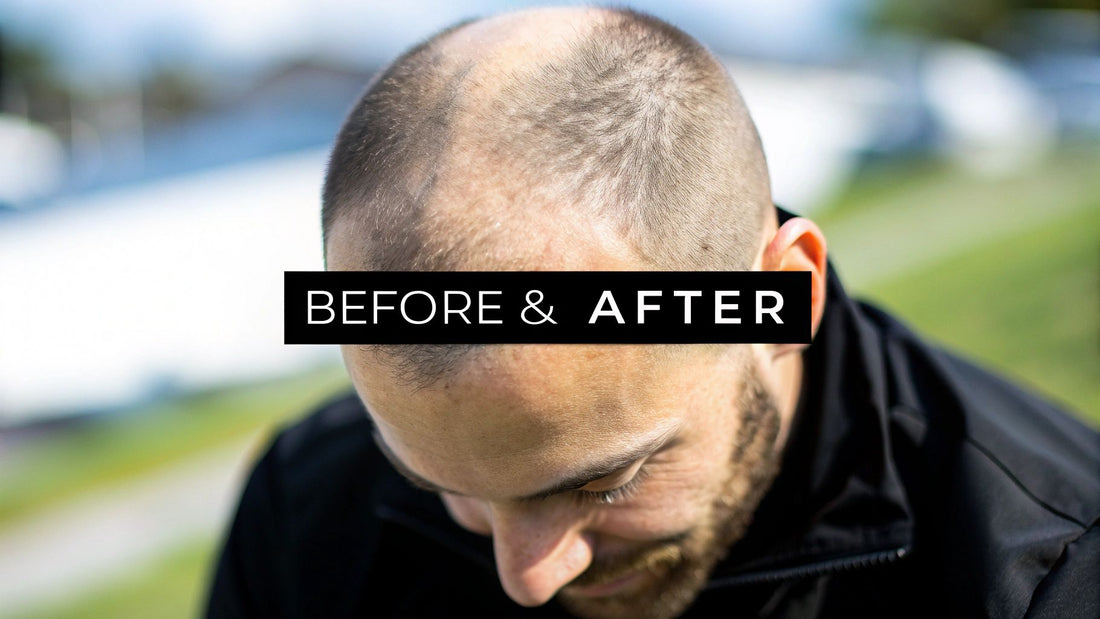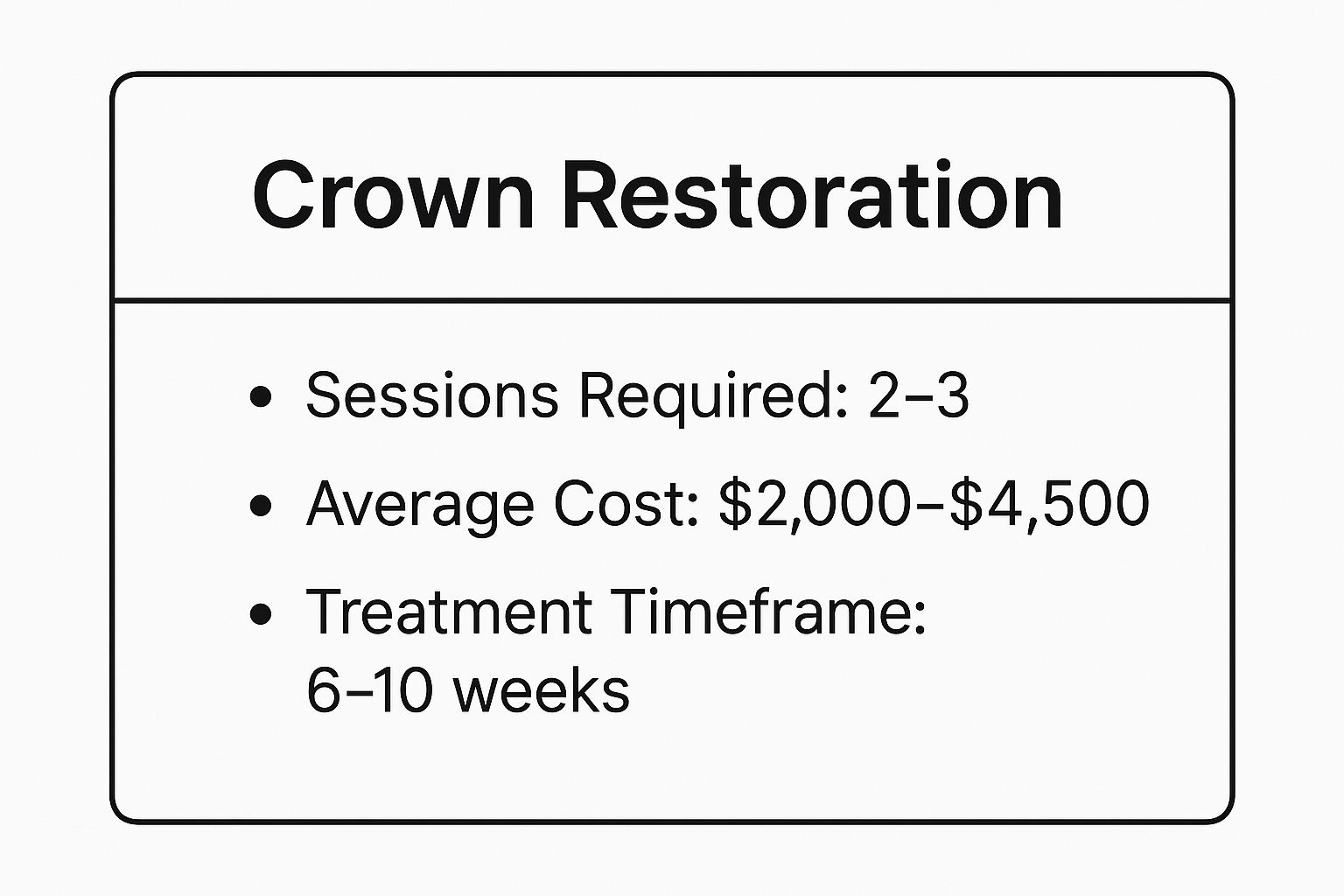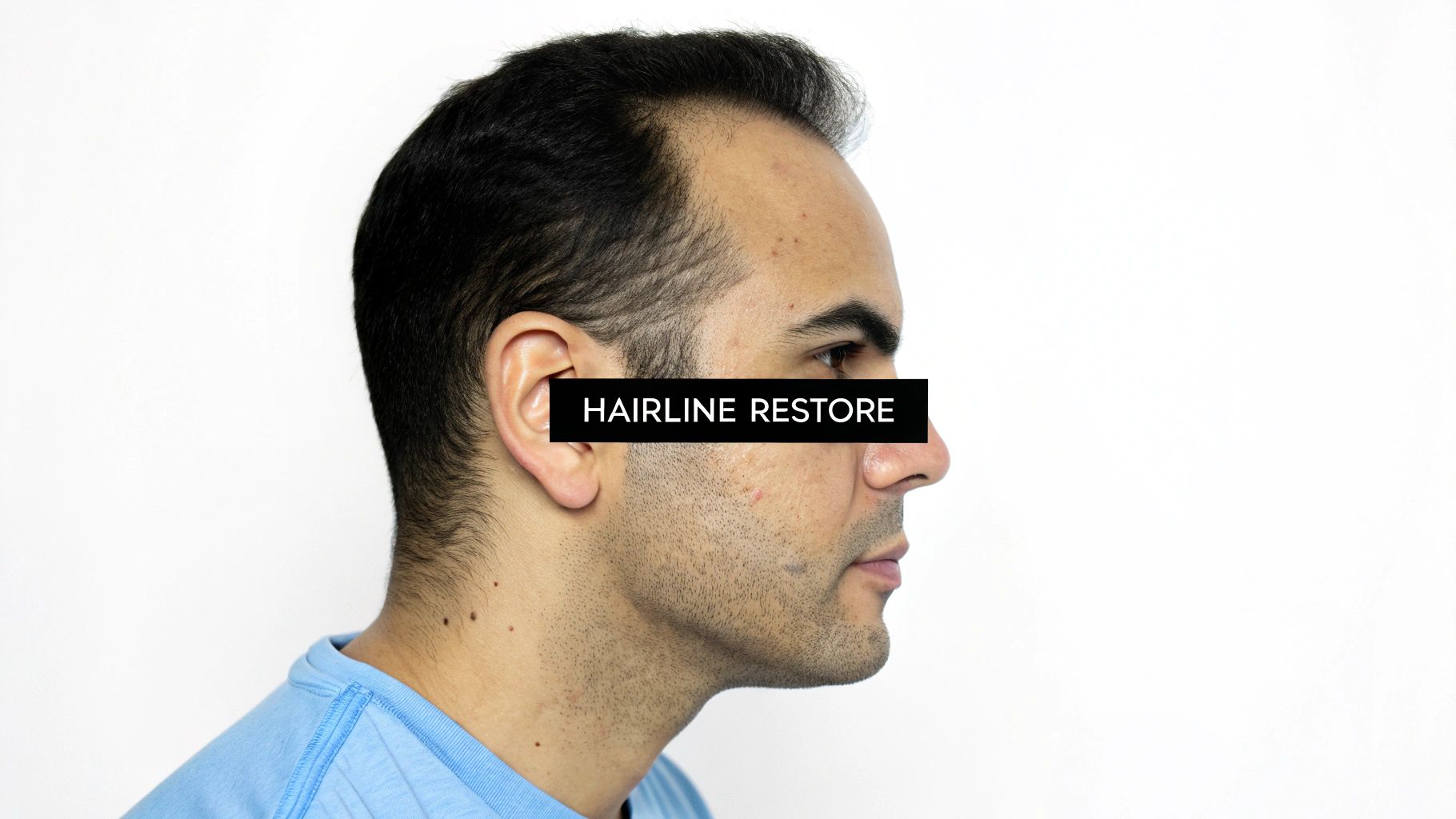
6 Stunning Scalp Micropigmentation Before After Results (2025)
Share
Thinking of getting scalp micropigmentation? Seeing is believing. The most powerful way to understand the impact of this innovative hair loss solution is to see real-world results. A well-executed SMP treatment can dramatically restore confidence, but the final outcome depends entirely on the technician's skill and the strategic approach taken for each unique case of hair loss. This is why examining scalp micropigmentation before after photos is so crucial.
This listicle moves beyond simple success stories. We will analyse a diverse range of client transformations, breaking down the specific techniques and strategies used to achieve natural, seamless results. You will see how practitioners address everything from common male pattern baldness and receding hairlines to more complex situations like alopecia and hair transplant scar camouflage.
For each example, we'll provide:
- A deep strategic analysis of the client's initial condition and the goals of the treatment.
- Specific tactical insights into the methods used, such as pigment selection and density application.
- Actionable takeaways to help you understand what to look for and discuss with your own SMP artist.
By the end, you'll have a clear, comprehensive understanding of what's possible with modern scalp micropigmentation.
1. Male Pattern Baldness Crown Restoration
Male pattern baldness, particularly advanced cases on the Norwood Scale (5-7), often results in significant hair loss concentrated at the crown. A crown restoration using scalp micropigmentation (SMP) is a highly effective, non-invasive solution. It meticulously replicates thousands of tiny hair follicles using specialised pigments, creating a dense, natural-looking appearance that seamlessly blends with existing hair.
This technique is a game-changer for individuals seeking the look of a full head of shaven hair. Unlike hair systems that require ongoing maintenance or surgical options that are not suitable for everyone, SMP offers a permanent camouflage. The practitioner's skill is paramount here; they must carefully match pigment colour to the client’s skin undertones and natural hair colour, layering impressions over multiple sessions to build realistic density. This is a key reason why scalp micropigmentation before after transformations for crown balding are so dramatic and life-changing for many.
Strategic Breakdown
The success of a crown restoration hinges on creating flawless density and a seamless blend. Practitioners achieve this by varying the pigment shades and impression sizes to mimic the natural, multi-tonal appearance of a real head of hair.
Key Strategy: The primary goal is not just to cover the bald spot but to create an illusion of depth and texture. This is accomplished by layering pigment over 2-3 sessions, allowing the practitioner to build density gradually and make micro-adjustments for a hyper-realistic result.
This meticulous approach ensures the treated area is indistinguishable from the surrounding hair, as showcased in many case studies from pioneers like HIS Hair Clinic and Scalp Micro USA.
Actionable Insights & Tips
To get the best possible results from your crown restoration, consider these expert tips:
- Practitioner Portfolio: Focus on practitioners with an extensive portfolio of crown-specific work. Ask to see examples of healed results on clients with similar hair loss patterns and skin tones to your own.
- Maintain Hair Length: For the most convincing illusion, keep your hair buzzed to a consistent length of 1-2mm. This prevents a noticeable difference in texture between your real hair and the pigmented follicles.
- Sun Protection: Schedule your sessions during cooler months if possible to minimise sun exposure, which can cause fresh pigment to fade. Post-treatment, diligent use of sunscreen on the scalp is crucial.
- Follow Aftercare: Proper aftercare is non-negotiable for pigment retention and healing. For detailed instructions, you can learn more about scalp micropigmentation aftercare on MyTransformation.com.au.
The following infographic provides a quick reference for the typical requirements of a crown restoration procedure.

This data highlights that achieving a full crown restoration is a multi-step process completed over several weeks, underscoring the importance of patience and commitment to the treatment plan.
The video below from Tino Barber documents a complete 3-session crown restoration, providing a fantastic visual of the scalp micropigmentation before after journey.
2. Receding Hairline Reconstruction
A receding hairline is one of the most common and earliest signs of hair loss, significantly impacting facial framing and perceived age. Scalp micropigmentation offers a precise and artistic solution by reconstructing the hairline, creating the look of a full, sharp hairline on a closely shaven head. The process involves implanting pigment dots to replicate hair follicles, effectively restoring the hairline to a more youthful yet natural position.

Unlike outdated "hair tattoos," modern SMP for hairlines is a sophisticated art form. Practitioners like Italian pioneer Milena Lardi and the experts at Vinci Hair Clinic have perfected techniques to design hairlines that are age-appropriate and flattering. The goal is to avoid unnaturally sharp or low hairlines, instead opting for soft, slightly staggered edges that mimic real hair growth patterns. The scalp micropigmentation before after results for hairlines are often striking, completely reframing the face and restoring a sense of confidence.
Strategic Breakdown
Creating a believable hairline requires a collaborative approach between the client and practitioner. It's a balance of aesthetic desire and what will look natural for years to come. The practitioner must meticulously blend the new hairline into any remaining frontal hair and temple points.
Key Strategy: The most crucial element is hairline design. A successful practitioner will not create a perfectly straight line. Instead, they build a 'broken' or 'scattered' hairline with micro-irregularities, using varied pigment shades and dot sizes to create a soft, feathered edge that appears entirely natural up close.
This detailed method ensures the hairline doesn't look artificial or drawn-on, which is a common fear for many clients. It’s the artistry in this imperfection that makes the treatment undetectable. For those considering this option, you can discover more about why scalp micropigmentation is the answer to hair loss.
Actionable Insights & Tips
To ensure your hairline reconstruction is a success, pay close attention to these details:
- Study Hairline Portfolios: Don't just look at general SMP work. Specifically request to see healed photos and videos of hairlines created by the practitioner. Look for soft, natural edges, not harsh, overly defined lines.
- Design Conservatively: When discussing the design, it's wise to start with a slightly more mature or conservative placement. A hairline that is too low or straight can look unnatural as you age. It can always be subtly adjusted in future sessions if desired.
- Trust the Process: Density is built over multiple sessions. The first session will establish the shape, but the hairline will look sparse. Subsequent sessions add the necessary density and subtle texturing for a realistic finish.
- Match Your Buzz Cut: For a seamless blend, you must maintain a consistent, closely buzzed hairstyle. This prevents a visible texture difference between your real hair stubble and the pigmented follicles.
3. Hair Transplant Scar Camouflage
Hair transplant surgery, while effective, can leave behind noticeable scars. Follicular Unit Transplantation (FUT) often results in a linear scar across the back of the head, while Follicular Unit Extraction (FUE) can create a pattern of small, circular "dot" scars. Scalp micropigmentation offers a specialised solution to conceal these marks, meticulously depositing pigment into and around the scar tissue to break up its visibility and blend it with the surrounding hair follicles.
This technique is a lifeline for individuals who are unhappy with the tell-tale signs of a past procedure. The goal is to make the scar virtually undetectable, especially when the hair is kept short or buzzed. A skilled practitioner uses varied pigment shades and impression densities to match the texture and colour of the native hair, effectively camouflaging the scar. The incredible difference seen in scalp micropigmentation before after photos of scar treatments makes it an essential post-transplant consideration for many.

Strategic Breakdown
Successfully camouflaging scar tissue is an art that requires a different approach than treating a standard bald area. Scar tissue absorbs and retains pigment differently from healthy scalp skin, making practitioner experience paramount.
Key Strategy: The primary objective is to soften the scar's appearance, not to completely obliterate it with dense pigment. This is achieved by using multiple light passes and slightly varied pigment shades to create a stippling effect that breaks up the scar's solid line or texture, allowing it to blend naturally.
This careful layering technique, demonstrated by experts at Brandwood Clinic and other medical SMP clinics, ensures the final result is subtle and realistic, avoiding an unnatural, dark patch over the scar.
Actionable Insights & Tips
To ensure your hair transplant scar is concealed effectively and safely, keep these expert tips in mind:
- Patience is Key: You must wait at least 12 months after your hair transplant surgery before undergoing SMP. This allows the scar to fully heal, mature, and settle, providing a stable canvas for the pigment.
- Find a Scar Specialist: Do not choose a general SMP artist. Seek out a practitioner with a specific, extensive portfolio showcasing successful FUT and FUE scar camouflage on healed clients.
- Consider Combination Treatment: For the most seamless blend, you may need SMP on the surrounding scalp area, not just the scar itself. This creates a uniform look of density, especially if you keep your hair very short.
- Manage Expectations: Be aware that scar tissue may fade faster than the surrounding scalp. You might need touch-up sessions sooner than you would for standard SMP treatment. If you want to dive deeper into the process, you can find out more about using scalp micropigmentation for hair transplant scars on MyTransformation.com.au.
4. Alopecia Areata Complete Coverage
Alopecia, in its more advanced forms like alopecia totalis (complete scalp hair loss) or universalis (complete body hair loss), presents a unique challenge that scalp micropigmentation is exceptionally equipped to handle. SMP offers a full-coverage solution that masterfully recreates the appearance of a full head of hair in a closely shaved or buzz-cut style. This is achieved by meticulously applying pigment impressions across the entire scalp, from the frontal hairline to the crown and nape.
Unlike treatments for pattern baldness that blend with existing hair, this application requires the practitioner to build an entire "head of hair" from a blank canvas. The process involves creating a new hairline, establishing natural-looking density, and ensuring the pigment tones complement the client's skin perfectly. The resulting scalp micropigmentation before after transformation for alopecia clients is often one of the most profound, restoring a sense of identity and confidence that hair loss has taken away.
Strategic Breakdown
For a full alopecia treatment, success is defined by total realism. The practitioner must be an artist, building a convincing hairline, creating subtle variations in follicle density, and ensuring the final look is age-appropriate and suits the client’s facial structure. It's a comprehensive reconstruction rather than a simple camouflage.
Key Strategy: The entire treatment is planned as a cohesive whole. Practitioners map out the entire scalp, designing a soft, natural hairline and a gradual fade into the temporal points. Density is built over multiple sessions (often 3-4) to create an illusion of three-dimensional depth, which is vital when no real hair is present.
This approach is championed by medical SMP specialists and documented in case studies from organisations like Alopecia UK, showcasing how SMP provides a reliable, long-term cosmetic solution.
Actionable Insights & Tips
Achieving a natural look with full SMP coverage requires careful planning and practitioner selection. Consider these expert recommendations:
- Alopecia-Specific Experience: Prioritise practitioners who have a robust portfolio of alopecia totalis or universalis cases. Their experience in hairline design and full-scalp density creation is fundamentally different from standard balding treatments.
- Prepare for a Dramatic Change: Unlike gradual hair loss, the change from having no hair to a full "shaved look" overnight is significant. Mentally prepare for this positive but dramatic shift in your appearance.
- Plan for a Longer Timeline: Full coverage is an extensive process. Be prepared for 3-4 sessions spread over several weeks to allow for proper healing and density building between appointments.
- Budget Accordingly: This is one of the most complex and time-consuming forms of SMP. The cost reflects the high level of skill and hours required, so budget for a premium, experienced artist. For more details on the nuances of this treatment, you can find in-depth information about scalp micropigmentation for alopecia on MyTransformation.com.au.
5. Women's Hair Loss Pattern Coverage
Female pattern hair loss typically presents as diffuse thinning across the scalp, often starting at the part line, rather than the distinct bald areas common in men. Scalp micropigmentation for women is a specialised, delicate procedure designed to reduce the visible contrast between the scalp and hair. By artfully placing pigment impressions between existing hair strands, practitioners create an illusion of greater hair density and a fuller-looking head of hair.
This technique is a powerful confidence-booster for women experiencing thinning, as it camouflages the scalp without affecting the remaining hair. Unlike powders or fibres that can be messy and require daily application, SMP offers a semi-permanent solution that looks natural under any conditions. The scalp micropigmentation before after results for women are often subtle yet profound, restoring the appearance of fullness and effectively masking the thinning areas. The focus is on density building rather than hairline creation, a key difference from male SMP treatments.
Strategic Breakdown
Success in female SMP lies in creating a subtle shadow effect on the scalp that minimises the stark white appearance of the skin showing through the hair. The practitioner must work carefully around and between existing long hairs, which makes the application process more intricate than on a shaved head.
Key Strategy: The primary objective is to add visual density. This is achieved by using a slightly darker pigment shade than the client's hair root colour to create a "shadow" effect. This strategic colouring makes the hair appear thicker at the base, reducing the visibility of the scalp through the part line and other thinning zones.
This nuanced approach, championed by female SMP specialists like Dorothee Gilbert, ensures the treatment enhances the existing hair without looking artificial, as seen in many client testimonials from women's hair loss support groups.
Actionable Insights & Tips
To achieve the best outcome for female pattern hair loss coverage, consider these expert recommendations:
- Find a Specialist: Prioritise practitioners who have an extensive portfolio specifically showcasing healed SMP results on women with long hair. Their experience in density work is crucial.
- Consider Hormonal Factors: Discuss your hair loss journey with the practitioner, including any hormonal influences (e.g., postpartum, menopause). This helps in planning the treatment and managing expectations for future touch-ups.
- Plan for Colour Changes: If you regularly colour your hair, discuss this with your practitioner. They can select a versatile pigment shade that will complement a range of potential hair colours.
- Discuss Styling: Understand any temporary hairstyling limitations post-treatment. For comprehensive information on how SMP can be tailored to female hair loss, you can find out more about how to treat women’s hair loss with scalp micropigmentation on MyTransformation.com.au.
6. Cancer Patient Post-Chemotherapy Treatment
Hair loss resulting from chemotherapy or radiation is a common and emotionally taxing side effect for cancer patients. For survivors, scalp micropigmentation offers a compassionate and effective way to restore the appearance of hair, reclaiming a sense of self and normalcy post-treatment. This specialised SMP application focuses on recreating a full, natural-looking hairline and density on a scalp that may be more sensitive.
The process is more than just cosmetic; it's a restorative step in a patient's recovery journey. Practitioners must work with utmost care, often in collaboration with a client’s medical team, to ensure the scalp is ready for treatment. The scalp micropigmentation before after results for cancer survivors are profoundly impactful, helping to close a difficult chapter and rebuild confidence that was diminished by the physical effects of treatment.
Strategic Breakdown
The core challenge is addressing a sensitive scalp while achieving a natural look, especially when hair regrowth is uncertain or patchy. The practitioner’s approach must be gentle and precise, often using finer needles and spacing sessions further apart to allow for optimal healing.
Key Strategy: The primary objective is restorative camouflage combined with psychological support. Practitioners focus on a delicate application, building density slowly over several sessions to avoid irritating sensitive skin. This gradual approach is crucial for both physical comfort and emotional adjustment to the new look.
This empathetic and medically-informed technique is championed by organisations and clinics that partner with cancer support charities like Look Good Feel Better and Maggie's Centres, ensuring a safe and supportive environment.
Actionable Insights & Tips
For cancer survivors considering SMP, a careful and informed approach is essential for a positive experience and outcome:
- Oncologist Clearance: Always obtain clearance from your oncologist before proceeding. They can confirm your scalp has sufficiently recovered and that the treatment is safe for you.
- Find Medical SMP Specialists: Seek out practitioners who have specific experience working with post-chemotherapy clients. Ask about their protocols for sensitive skin and view their portfolio of similar medical cases.
- Timing is Key: Discuss the optimal timing with your practitioner. Most recommend waiting at least six months after your final chemotherapy or radiation session to ensure your skin has stabilised.
- Plan for Sensitivity: Your scalp may be more sensitive than usual. Communicate openly with your practitioner about any discomfort during the procedure so they can make adjustments.
Before & After Comparison of 6 Scalp Micropigmentation Cases
| Treatment Type | Implementation Complexity 🔄 | Resource Requirements ⚡ | Expected Outcomes 📊 | Ideal Use Cases 💡 | Key Advantages ⭐ |
|---|---|---|---|---|---|
| Male Pattern Baldness Crown Restoration | Moderate; 2-3 sessions over 6-10 weeks | Moderate; skilled SMP artist, pigment | Natural-looking crown coverage, shaved head illusion | Advanced male pattern baldness (Norwood 5-7) | Dramatic visual change, no surgery, immediate results |
| Receding Hairline Reconstruction | Moderate-High; requires artistic precision | Moderate; custom design and skillful dot placement | Restored youthful hairline, natural irregular pattern | Frontal hair loss, hairline recession | Customizable, confidence boost, works with existing hair |
| Hair Transplant Scar Camouflage | High; specialized needle techniques for scar tissue | Moderate; experienced scar specialist | Concealed scars blended with natural scalp | Concealing FUT or FUE transplant scars | Quick scar concealment, improves transplant appearance |
| Alopecia Areata Complete Coverage | High; extensive sessions (3-4+) over months | High; full scalp coverage and planning | Full scalp density simulation, shaved head look | Complete scalp hair loss (alopecia universalis) | Permanent, dramatic visual transformation, psychological benefit |
| Women's Hair Loss Pattern Coverage | Moderate; subtle density work with longer hair | Moderate; female SMP experience required | Fuller, natural feminine density | Female pattern hair loss, diffuse thinning | Maintains longer hairstyles, subtle enhancement |
| Cancer Patient Post-Chemotherapy Treatment | High; sensitive scalp care, medical coordination | High; medical clearance and flexible scheduling | Restored scalp appearance, emotional confidence | Hair loss from chemotherapy/radiation | Psychological healing, insurance/charity support |
Final Thoughts
As we've explored through these detailed examples, the power of scalp micropigmentation before and after transformations is undeniable. The journey from initial consultation to the final, settled result is a testament to the artistry and technical precision required for this sophisticated procedure. We've analysed a diverse range of applications, from reconstructing a natural-looking hairline for male pattern baldness to providing density for women experiencing diffuse thinning, and even masterfully camouflaging hair transplant scars. Each case study has offered a unique window into the strategic thinking behind a successful SMP treatment.
The key takeaway is that outstanding results are never accidental. They are the product of a meticulous, personalised approach. A skilled practitioner doesn't just apply pigment; they analyse follicle direction, skin tone, hair colour, and long-term fading to create a three-dimensional illusion of hair that is virtually indistinguishable from the real thing. This is the core difference between a standard procedure and a truly life-changing transformation.
Key Insights from Our Analysis
Reflecting on the various before and after scenarios, several critical themes emerge:
- Customisation is King: As seen in the receding hairline and women's hair loss examples, a one-size-fits-all approach fails. The most successful outcomes are tailored to the individual’s unique facial structure, age, and hair loss pattern.
- Layering for Depth: The crown restoration and alopecia coverage cases highlighted the importance of multiple sessions. Building density through carefully layered impressions creates a realistic, textured appearance that single-session treatments simply cannot replicate.
- Strategic Blending: Scar camouflage is perhaps the best example of strategic artistry. The practitioner must seamlessly blend the pigmented area into the surrounding hair, feathering the edges to ensure the scar becomes completely unnoticeable.
Understanding these principles is crucial for anyone considering this procedure. It empowers you to ask the right questions during a consultation and to set realistic, informed expectations. The scalp micropigmentation before after photos are not just about the final look; they represent a carefully executed plan designed to restore confidence and redefine a person's relationship with their appearance.
Your Next Steps on the SMP Journey
If the transformations we've showcased resonate with you, the next step is to move from inspiration to action. Begin by researching qualified, experienced practitioners in your area. Scrutinise their portfolios, paying close attention to the quality of their hairline work, the subtlety of their pigment blending, and the consistency of their results across different client types.
Prepare for your consultation by taking photos of your hair loss from various angles and thinking about your desired outcome. Do you want a sharp, defined hairline or a softer, more mature look? The more clarity you have, the better a practitioner can guide you. This isn't just a cosmetic treatment; it's a collaborative process between you and your artist to achieve a result you'll be proud of for years to come. The most profound scalp micropigmentation before and after stories begin with this crucial step of diligent research and clear communication.
Ready to see what your own transformation could look like? The experts at My Transformation specialise in creating the hyper-realistic and personalised results we've discussed. Visit their gallery at My Transformation to see more incredible before and after stories and book your confidential consultation.
